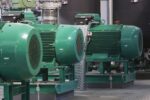
Edge computing
Online functionalities in industrial equipment offer many advantages, both for the producers and for the users. For example, automatic updates of operating software, or remote production monitoring or control. But the growing number of online sensors, actuators and other Industrial Internet of Things elements means higher demand in the field of data transport, storage and bandwidth – and these are not always available in unlimited quantities. Moreover, data processing through the cloud cannot always deliver the required reaction speed. The use of edge computing creates speed, freedom and flexibility without compromising on the functionality of your devices.
On-the-spot data processing
Edge computing enables data processing on the edge, the outer end of online cloud applications, where the data is collected. The transformation of data into useful information happens on the spot. One simple example of an edge device is a smoke sensor. This detects smoke and immediately emits an alarm. Application of edge devices can similarly be useful for more complex data processing procedures. Thus visual sensors of sorting or packaging machines can be equipped with built-in processors with artificial intelligence for pattern recognition.
Edge computing means fewer data is sent to the cloud, the requirement for back-office storage is reduced, and reaction speed is drastically lowered. Moreover, the reduced demand for storage in calculating centers means a smaller carbon footprint. TNL develops edge devices that are equipped with built-in algorithms for a variety of applications.
Our customer cases
Let’s talk about Edge computing
And find out how we can help you



